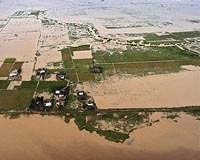 |
Paris (AFP) Oct 7, 2009 Feeding Earth's expected population of nine billion by 2050 will need a switch in eating habits and farming practices if inequalities and environmental overload are to be avoided, French researchers said on Wednesday. Teams from two institutes sketched projections for what could happen over the next four decades as the world's population swells by around 2.5 billion. The statistical basis for their study was food production between 1961 and 2003, a period that included the "green revolution" of rice production that especially benefited Third World countries. The researchers put forward one scenario that followed historical trends in food output and use of land in an open-market manner. Under this projection, production would grow by 2050 thanks to intensive farming. However, the movement towards meat production would also accelerate, inequalities between the nutritionally rich and nutritionally poor would widen, and environmental issues -- as today -- would only be addressed after they have become a problem. A rival scenario sees low-intensivity, sustainable farming where meat or fish would account for around 500 calories in an average daily intake of 3,000 per person, or around 15 percent of the diet compared with 17 percent in 2003. Meat farming requires large inputs. Every calorie of meat produced by a cow or sheep requires seven calories of grass and other vegetation. For chickens and pigs, the ratio is one to four. Achieving the goal of 3,000 calories per head would entail a cut of around quarter in daily intake in rich countries today and a corresponding rise in sub-Saharan Africa. Two factors would help the fight to feed the billions, the institutes said. One is the big gains that can be made from fighting waste. Globally, more than a third of food produced each day is lost in the fields, in processing plants and distribution. Another is the growing preponderance of the elderly. By 2050, "the average age of the world's population will have increased by 10 years. When a population ages, the calorific needs fall," Marion Guillou, president of the National Institute for Agricultural Research (INRA), said. The report, co-written with the Agricultural Research Centre for International Development (CIRAD), cautioned that achieving the second scenario would require market regulation and protection for the growing of staple foods in poor countries. Share This Article With Planet Earth
Related Links Farming Today - Suppliers and Technology
 Philippine rice farmers facing tough times
Philippine rice farmers facing tough timesManila (AFP) Oct 6, 2009 Thousands of rice farmers in the northern Philippines are facing hardship and going further into debt after a typhoon mowed down stalks a week before harvest, officials said. Swathes of rice farms were laid to waste or heavily flooded after Typhoon Parma scythed through the farming provinces of Cagayan, Isabela and Ilocos with hurricane-force winds and heavy rains. "No amount of ... read more |
|
| The content herein, unless otherwise known to be public domain, are Copyright 1995-2009 - SpaceDaily. AFP and UPI Wire Stories are copyright Agence France-Presse and United Press International. ESA Portal Reports are copyright European Space Agency. All NASA sourced material is public domain. Additional copyrights may apply in whole or part to other bona fide parties. Advertising does not imply endorsement,agreement or approval of any opinions, statements or information provided by SpaceDaily on any Web page published or hosted by SpaceDaily. Privacy Statement |